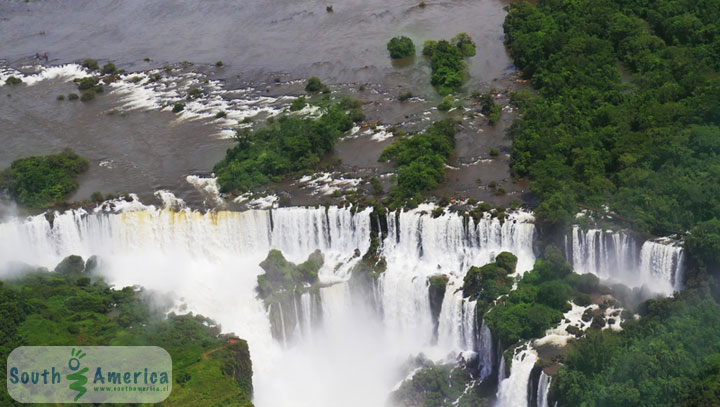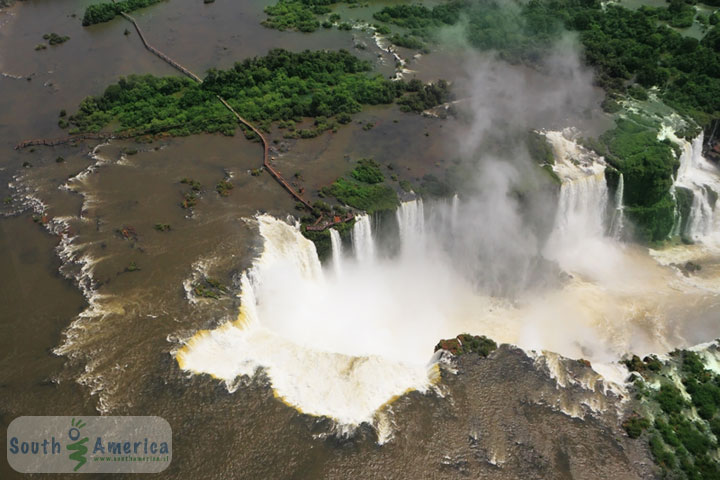Iguazu Falls
South America

The Iguazu falls are comprised of more than 270 different smaller falls, some of which can be connected during peak flow. The general shape is that of a horseshoe so that tourists feel encompassed by the cascades for 3 km in length and plunging some 82 metres. (Imagine it is as tall as a 24-storey building.)
The falls are so high with such a large amount of water that the mist can rise as much as 150 metres or 500 feet in the air. Because of this the falls are considered one of the best places in the world to take a picture of a rainbow! The constant waterfalls play with the light creating several beautiful rainbows all throughout the falls.
The parks encompassing the Iguazú Falls and part of the Iguazú River are beautiful lush rain forests filled with all kinds of wildlife. You can take some really fantastic trails while there; some guided tours are dedicated to topics such as the local bird life. Tourists should be careful of jaguars and other big cats while in the forests. One of the cuter animals in the area are the groups of coatis that lack any real fear of humans. This could be because many tourists feed the animals even though there are several signs posted about the animals being wild and dangerous.
The falls are encompassed in two national parks and some of the most important rain forests in the world. Both of the national parks (one in Argentina and the other in Brazil) have been declared World Heritage sites by UNESCO and thankfully have special protection to guard them as world treasures.
Garganta del Diablo Waterfall
The most famous portion of the waterfall is the Devil's throat, or "Garganta do Diablo" in Portuguese. It has water flowing in from three different sides, making it incredibly unique. From the Argentinean side it is possible to take a pathway that goes directly over the area, not a bad place to stop and take a photograph. The catwalk is an incredibly experience where you will be so close to the water that your clothes will end up drenched and you won't be able to hear your travel companion cheerfully shout at you.
You can see part of the walkway to the Garganta del Diablo in the aerial photo of the falls below.

When to Go
Spring and Autumn are generally the best choices for visiting the falls, although these peak times can also be a bit more expensive. Summer is only pleasant if you enjoy having your clothes stick to you as you hike around the waterfalls. Summer in the rain forest is overwhelming for many tourists, and it is also rainy season. Rainy season means that the falls are at their strongest flow, but that some of the trails can be closed. The major problem in winter is with hostels that are not well equipped to keep the bedrooms toasty at night, and of course the later into dry season, the water begins to dwindle and lose its "awe factor".
The Brazilian side or the Argentinean side?
The general belief is that a tourist requires two full days to see the falls, one for the Argentinean side with its close up views, catwalks and maybe a boat ride and then another day for the Brazilian side where you can take in Iguazú from all its magnitude. Some tourists might want to spend extra time here however, either enjoying nature walks through the rain forest or practicing white water rafting or rock climbing.
On both sides the parks fill quickly with tourists from all over the world, so it is recommended that you go as early as possible during the day, although you'll never really be alone.
Argentinean Side
Start your day catching the bus to the Information center and purchase your entrance tickets into the park.
Centro de Informes: Here there is a tower that you can climb for a good bird's eye view and a small museum about the natural history of the waterfalls. There is also a gift shop and some snack bars in case you missed out on breakfast before your bus left.
Hop on the train that takes you to a number of different stops with pathways to check out the falls from different vantage points.
Different walks include the upper circuit (1 hour), lower circuit (2 hours), devil's throat catwalk (45 minutes) as well as the San Martin Island trail (45 minutes).
The lower circuit is the most difficult of all the walks at Iguazu. It has a series of stairs. We recommend doing this first while you have all your energy. From the end of this trail you can catch a boat to the San Martin Island.
Taking the boat to San Martin, and then taking one of the tourism companies' boats to the base of the Devil's Throat and under some of the other cascades is a really spectacular way to gain a different vantage point.
After hiking back get on the train again to the Devil's Throat. There is a little restaurant area here at the station and from there you can take an easy walk over to the spectacular Devil's throat where there is an observation deck.
Some tourism agencies will take you on different boat rides as well, and on other spots along the river there is even the possibility of white water rafting.
There is also the possibility of moonlit walks when there is a full moon. Imagine walking through the forest and listening to the sounds of the rain forest and the rushing sounds of water, only to emerge from the darkness to find the enormous cascades. Keep in mind that many of the wildlife predators are nocturnal, so you need to be extra careful on these walks.
The main city for tourists to stay when visiting the falls on the Argentinean side is Puerto Iguazú.
Brazilian Side
The Brazilian side of the falls is closed on Mondays.
The Brazilian side actually receives more tourists than the Argentinean side, as there is a larger selection of hotels and tourist companies located here.
The visitor center is located 20 km from the city of Foz do Iguaçu and is easily accessible by bus. It is here in the information center that you need to purchase your ticket to explore the park. This ticket includes the bus from the information center directly to the falls and different trails.
You can hire a guide to go with you to the falls to explain more about the waterfalls, or just pick up some handy brochures in the visitor center and be on your way.
The Macuco trail takes you down to the base of the waterfalls and from there you are able to hop into a boat. The walk takes approximately an hour. It is the only real trail on the Brazilian side.
There are other stop off points however with great views of the Devil's throat and a general panoramic view of all of the cascades.
Technically the park is open from 8am to 6pm, but with summer light they normally allow guests to stay until 8pm.
One of the high class ways to check out the waterfalls from Brazil is to take an helicopter ride. While it is a rather expensive and short tour it allows for views of the falls that few people have the chance to see.
The main city for tourists wanting to visit the falls from the Brazilian side is Foz do Iguaçu.
Border Crossings
American tourists need to be sure that they plan ahead of time for a Brazilian visa. Even if you are only entering the country for the day to visit the falls you are still subject to a reciprocal fee (The same amount paid by Brazilians visiting the United States).
It is sometimes overlooked if you have the return ticket for the day ready, but you shouldn't count on this.
Local buses travelling from Foz do Iguaçu to Puerto Iguazú or vice versa tend not to stop and wait for you to do the paperwork at the border check point. Be sure that you ask to be let off and then when finished with your stamps hail the next bus that comes along.
If you don't want to deal with this local system you can always join up with one of the private tour groups, or most of the better hostels and hotels have their own buses to avoid all the hassle.
Entering Paraguay also requires a visa for Americans now. It is best to check with your embassy or the tourist information centers there when going as the conditions and requirements continually change.
Traveller's Tip: Remember that there are several companies all depending on tourism here with fierce competition. Don't be afraid to haggle a little bit and search for better deals. Even some of the nicer hotels are known to give reduced prices to backpackers just to fill extra rooms.
Traveller's Tip: Be sure to bring your camera and try to keep it in a water safe bag as some of the trails involved getting sprayed with mist and boat rides sometimes go underneath the falls.
Traveller's Tip: While walking around the rain forest try looking for the harpy eagle. (Águila harpía) This ferocious bird uses its powerful sharp talons and beak to break the skull of a monkey, its preferred feast. It will be a feat to find one as they are on the endangered species list, but this area of Brazil does have the largest population.
A Little History about the Iguazu Falls
The name of the waterfalls Iguazu means "great water" in the Guarani language. The Spanish explorers renamed it the Santa Maria cascades in the 16th century, but they couldn't get the name to stick.
The Guarani legend of the waterfalls tells the story of an angry god who in some stories takes the shape of a snake. The local people had to sacrifice a virgin each year to please the god so that the river would continue to flow. In other versions this specific virgin was set aside to become the wife of the god. She already had a mortal lover and the young warrior decided he would not give his love away to the vengeful god. The two mortals fled. The god displeased with her escape in a canoe split the river so that the couple would fall to their deaths. She was turned into a rock from the fall and he became an overhanging tree, separated but within sight of his lover.
If you found this guide about the Iguazu Falls interesting or useful, let others know about it.

